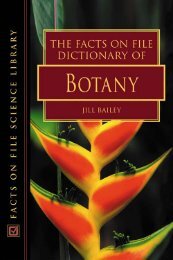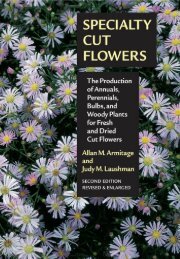You also want an ePaper? Increase the reach of your titles
YUMPU automatically turns print PDFs into web optimized ePapers that Google loves.
Xylem<br />
This complex tissue has twO principal roles: the<br />
transport of large quantities of water from the<br />
rOOt 10 the shoot in the tracheary elements (1.12)<br />
and the mechanical suppOrt of the aerial plant<br />
body (3.44). This support is provided both by the<br />
rracheary elements and the associated (often<br />
thicker-walled) non-conducting fibres (1.3, 3.28).<br />
Additionally, in the secondary xylem the axial and<br />
ray parenchyma (1.3, 3.14, 3.45) store food and<br />
water.<br />
Mature uacheary elements (loll, 3.17) afC<br />
dead and have lost their proroplasts (2.9, 2.l0).<br />
Their secondary walls are thickened relative to the<br />
primary walls (2.8, 2.l0} and, due to lignification,<br />
arc impermeable except at the pits where only<br />
primary wall is present (2.10). The trachcary elements<br />
are elongated and water moves along their<br />
lumina from the root to the shoot in the transpiration<br />
stream (1.12). The absence of a plasmalemma<br />
allows the \"iater to pass fairly freely from<br />
one clement w another via the numerous pits<br />
(3.46).<br />
In nearly all angiosperms the tracheary<br />
elements comprise both tracheids and vessels<br />
(3.47) bll[ generally only tracheids occur in<br />
gymnosperms and lower vascular plants (3.17,<br />
3.27,3.48). A tracheid is derived from a single cell<br />
and has no perforations; it is elongated, with<br />
tapering ends (3.47) and in conifers the tracheids<br />
(3.49) may reach a centimerre in length. By<br />
contrast, vessels are composed of a rube-like series<br />
of two to many vessel elements lying end to end.<br />
They are directly linked through their perforation<br />
plates (3.47, 3.50) which represent the remnants<br />
of their original end walls (3.51). Vessel elements<br />
tend to be shorter but wider than tracheids (3.47).<br />
The perforation plate shows either a single<br />
large pore (3.47) or in compound plates a number<br />
of elongated pores which arc commonly scalariform<br />
(3.14, 3.47). Because of these open pores<br />
vessels generally show a lower resistance to water<br />
movement than trachcids, where the closed pits<br />
impede water flow. In ringporous wood (1.3), the<br />
wide-diametered vessels (3.28) apparenrly extend<br />
many metres along the tree trunk. The tips of vessels<br />
are imperforate bur the numerous pits allow<br />
water to move into adjacent tracheary elements.<br />
The extent and type of the pitting in tracheary<br />
elements is variable (3.47 to 3.52). The protoxylem<br />
in the shoot shows secondary wall deposition<br />
of an annular or helical p:lttern (2.8, 2.9,<br />
3.50). The primary wall between thickenings<br />
becomes greatly extended after the protoxylem<br />
element dies whilst its non-cellulosic components<br />
are digested. The stretched wall often appears<br />
'holey' under TEM (2.66) and may rupture<br />
leaving a protoxylem cavity (1.11). In non-elonga-<br />
60<br />
ting regions of the plant, metaxylem elements<br />
show much more extensive secondary wall<br />
deposition of various patterns (3.52).<br />
In a scalariform element at least half of the<br />
primary wall is covered by secondary wall and the<br />
pits are horizontally elongated and usually<br />
bordered (3.52). In reticulate clements the<br />
thickening is more irregular (3.52) whilst in pitted<br />
elements (3.47, 3.48, 3.52) a greater proportion of<br />
the wall is secondary. Their pits occur in horizontal<br />
rows (opposite pitting, 3.52) or diagonally<br />
(alternate pitting 3.49, 3.57).<br />
In these various modes of secondary wall<br />
thickenings the intervening pits are bordered<br />
(2.10). In conifer tracheids the centre of the pit<br />
membrane (torus, 3.48) is thickened and lignified,<br />
but the periphery (margo) has only a loose<br />
cellulose network and is permeable. The pits<br />
between adjacent rracheary elements are abundant<br />
and bordered (2.9, 2.10, 3.46), but there arc few<br />
connections to fibres. The pits which link with<br />
parenchyma cells are either simple or halfbordered<br />
on the tracheary element side (3.46).<br />
Structure of wood<br />
In woody plantS the formation of secondary<br />
vascular tissue is rypicall)' periodic, since the vascular<br />
cambium becomes dormant in unfavourable<br />
environmental conditions. This typically results in<br />
the formation of growth rings in the secondary<br />
xylem of the tree (3.44, 3.45). In non-tropical<br />
species the cambial activity is limited by temperature<br />
and the rings usually represent annual incrementS<br />
(1.3, 3.17, 3.41, 3.44, 3.45). Generally the<br />
last-formed layers of xylem in a growth ring arc<br />
composed of narrower cells with thicker walls<br />
than the earlier wood (3.53), so that growth rings<br />
are often visible TO the naked eye (3.44). In many<br />
tropical trees (3.54) and desert succulents, growth<br />
rings are not obvious.<br />
The newly-formed tracheary elements of the<br />
sapwood condUCt water for a relatively short time.<br />
In stressful environments (for example nutrient<br />
deficient conditions) they often cease to function<br />
by the end of the first year, but in tropical trees<br />
they may remain active longer. The cessation of<br />
water transport in a tracheary elemenr results<br />
from cavitation (3.46). The rension on the water<br />
columns within tracheal)' lumina is grearest in the<br />
widest clements.<br />
Howe....er, when water is plentifully available in<br />
the soil, most condUCtion occurs within them since<br />
they offer less resistance to water flow than<br />
narrow elements. When the water supply is<br />
restricted, the tension on water columns in wide<br />
elements may become very severe. If a column<br />
breaks, an embolism quickly expands within the





